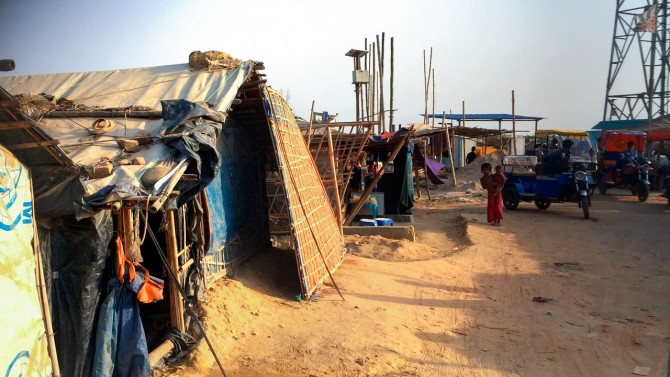Electronic food vouchers provided young Rohingya children in Bangladeshi refugee camps with better health and nutrition than direct food assistance, according to new research led by Cornell, in conjunction with the International Food Policy Research Institute.
At a Rohingya refugee camp in Bangladesh, conditions are poor, as shown in this photo by Professor John Hoddinott. But with electronic vouchers for wide variety of food, very young Rohingya children can obtain health and good nutrition by eating a diverse diet.
The electronic vouchers are provided by United Nations’ World Food Programme to Rohingya families forcibly displaced into refugee camps. As of last summer, more than 911,000 Rohingya – a Muslim minority ethnic group of Mynamnar nationals who have faced decades of persecution – were living in Bangladesh, where they relied on international aid for food, shelter and medical care.
The research, “Food Transfers, Electronic Food Vouchers and Child Nutritional Status Among Rohingya Children Living in Bangladesh,” was published April 29 in the online journal PLOS One.
“We were trying to assess the impact of the nutritional status of children,” said lead author John Hoddinott, the H.E. Babcock Professor of Food and Nutrition Economics, who holds appointments in the Division of Nutritional Sciences, the Charles H. Dyson School of Applied Economics and Management, and the Department of Global Development.
“The refugees are hungry and food-insecure. Giving them food helps but results in a monotonous diet,” he said. “Often people have a better idea of what foods they need. If families are given an electronic voucher – much like the Supplemental Nutrition Assistance Program in the U.S. – families can buy a range of food products in the small markets in the camps.
“In our observations, we found that Myanmar’s refugee children were better off if their household received an electronic voucher,” he said.
Hoddinott and his colleagues report that electronic food vouchers allow families to buy a greater range of nutritionally diverse foods. Electronic food vouchers are more efficient than transporting food. The Rohingya get about $9 a month in their electronic food vouchers, which look like debit cards.
“That supposition is consistent with what we know about the biology of children’s growth in this age range,” he said. “We don’t have data on what the children actually ate, but we know the households receiving the e-vouchers consumed a wider range of foods.”
In the humanitarian refugee camps, the economists measured the heights and weights of 523 children, ages 6 months to 23 months. They found that receipt of the electronic voucher was associated with improved height.
“These children are at a point in their development where they grow rapidly,” Hoddinott said. “That kind of growth requires a variety of foods that are calorically and nutrient dense.”
For 40 years, the Rohingya have periodically fled Myanmar to Bangladesh. More than 213,000 Rohingya were living in two refugee camps in southeastern Bangladesh in 2016. Further violence forced another mass exodus of more than 671,000 Rohingya to flee Myanmar in fall 2017, according to the paper.
Many dwellings are made from bamboo and plastic tarps, according to Hoddinott.
There are circumstances where delivering food is a better option, but “when we want to make these monetary transfers for vulnerable populations, we want to be as efficient as possible,” he said. “The money we spend on program administration or transporting food from one continent to another costs money that can’t be used to help people directly.”
In addition to Hoddinott, the study’s co-authors are Paul Dorosh and Gracie Rosenbach, International Food Policy Research Institute; Mateusz Filipski, University of Georgia; and Ernesto Tiburcio, Tufts University.









